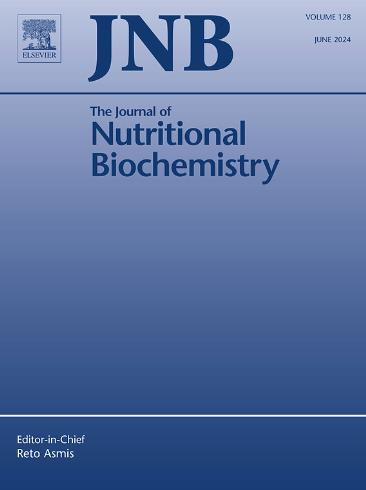柚皮苷通过促进线粒体NDUFS1易位和抑制心肌微血管内皮细胞铁下沉来减轻心肌缺血再灌注损伤。
IF 4.9
2区 医学
Q1 BIOCHEMISTRY & MOLECULAR BIOLOGY
引用次数: 0
摘要
目的:心肌微血管损伤在心肌缺血再灌注损伤(MI/RI)的进展中起关键作用。既往研究已证实柚皮苷(Nar)对心血管疾病具有保护心脏的作用。然而,心脏微血管在nar介导的MI/RI保护中的作用仍未被探索。本研究旨在探讨Nar对MI/RI大鼠心肌微血管内皮细胞(CMECs)功能的影响。方法:结扎大鼠左前降支45min,再灌注6h,建立心肌梗死/心肌梗死模型。体外建立cmec缺氧-再氧化(H/R)模型,缺氧12 H再氧化24 H。采用qRT-PCR、western blotting、透射电镜(TEM)、蛋白质组学分析、ELISA、TTC染色、免疫组织化学、免疫荧光、分子对接、分子动力学模拟等综合实验技术。结果:我们的研究结果显示,Nar通过抑制心肌梗死/心肌梗死期间cmes的铁下垂,显著增强心脏微血管功能。在机制上,暴露于H/R的MI/RI大鼠和cmec心脏中干扰素调节因子3 (IRF3)的磷酸化下调。Nar有效上调IRF3磷酸化,从而激活SLC7A11/Gpx4信号通路。此外,Nar促进NADH泛素氧化还原酶75 kDa Fe-S蛋白1 (NDUFS1)从细胞质转移到线粒体,增强线粒体功能并减轻H/ r处理的cmes铁死亡。结论:Nar促进NDUFS1线粒体易位,从而恢复线粒体功能,通过激活IRF3/SLC7A11/Gpx4轴抑制CMECs铁凋亡。本文章由计算机程序翻译,如有差异,请以英文原文为准。

Naringin attenuates myocardial ischemia-reperfusion injury by promoting mitochondrial translocation of NDUFS1 and suppressing cardiac microvascular endothelial cell ferroptosis
Cardiac microvascular injury plays a pivotal role in the progression of myocardial ischemia-reperfusion injury (MI/RI). Previous studies have demonstrated the cardioprotective effects of naringin (Nar) in cardiovascular diseases. However, the involvement of cardiac microvessels in Nar-mediated protection against MI/RI remains unexplored. This study aimed to investigate the impact of Nar on the function of cardiac microvascular endothelial cells (CMECs) in MI/RI rat. An MI/RI model was established in rats through ligation of the left anterior descending artery for 45 min followed by 6 h of reperfusion. In vitro, a hypoxia-reoxygenation (H/R) model was established in CMECs by subjecting them to 12 h of hypoxia and 24 h of reoxygenation. A comprehensive set of experimental techniques was employed, including qRT-PCR, western blotting, transmission electron microscopy (TEM), proteomic analysis, ELISA, TTC staining, immunohistochemistry, immunofluorescence, molecular docking, and molecular dynamics simulations. Our results revealed that Nar significantly enhances cardiac microvascular function by suppressing ferroptosis in CMECs during MI/RI. Mechanistically, phosphorylation of interferon regulatory factor 3 (IRF3) was downregulated in both the hearts of MI/RI rats and CMECs exposed to H/R. Nar effectively upregulated IRF3 phosphorylation, thereby activating the SLC7A11/Gpx4 signaling pathway. Furthermore, Nar facilitated the translocation of NADH ubiquinone oxidoreductase 75 kDa Fe-S protein 1 (NDUFS1) from the cytosol to the mitochondria, enhancing mitochondrial function and mitigating ferroptosis in H/R-treated CMECs. Nar promoted mitochondrial translocation of NDUFS1, thereby restoring mitochondrial function and inhibited CMECs ferroptosis via activation of the IRF3/SLC7A11/Gpx4 axis.
求助全文
通过发布文献求助,成功后即可免费获取论文全文。
去求助
来源期刊

Journal of Nutritional Biochemistry
医学-生化与分子生物学
CiteScore
9.50
自引率
3.60%
发文量
237
审稿时长
68 days
期刊介绍:
Devoted to advancements in nutritional sciences, The Journal of Nutritional Biochemistry presents experimental nutrition research as it relates to: biochemistry, molecular biology, toxicology, or physiology.
Rigorous reviews by an international editorial board of distinguished scientists ensure publication of the most current and key research being conducted in nutrition at the cellular, animal and human level. In addition to its monthly features of critical reviews and research articles, The Journal of Nutritional Biochemistry also periodically publishes emerging issues, experimental methods, and other types of articles.
 求助内容:
求助内容: 应助结果提醒方式:
应助结果提醒方式:


